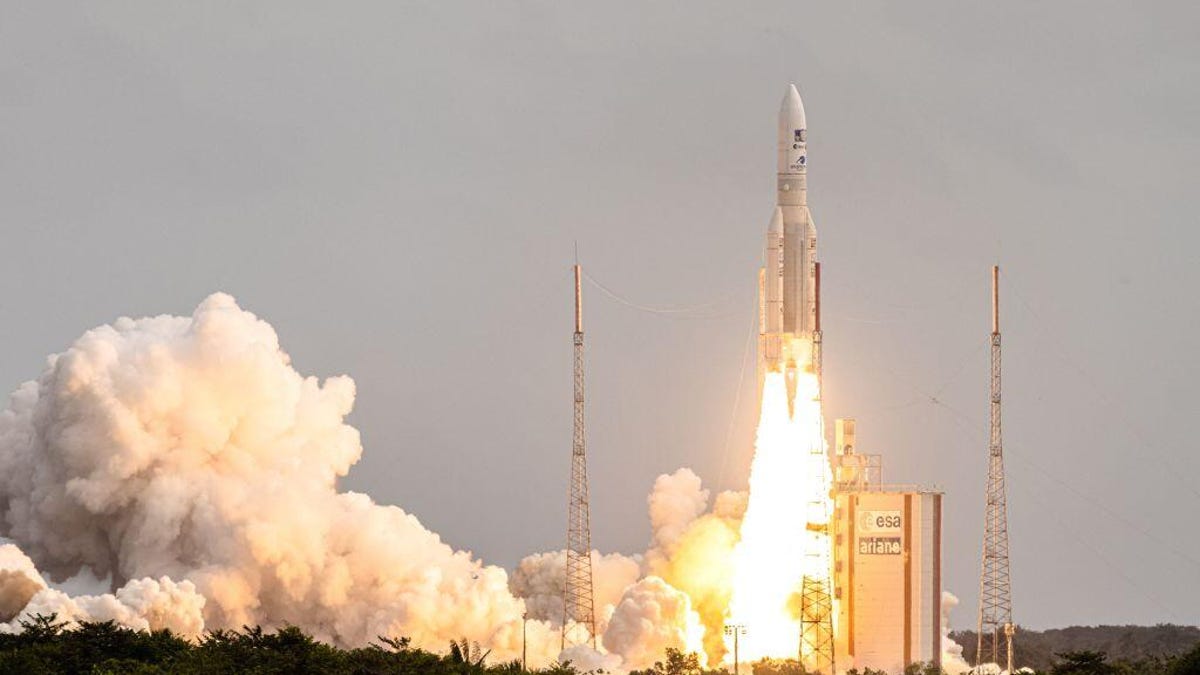Technologies
Here’s How to Watch Every Major US Space Launch Scheduled in 2025
Want to keep your eye on the sky in 2025? Here’s a look at the best space launches you can watch from the comfort of home.

Space agencies from around the world launched a total of 244 successful missions into orbit or space in 2024, which is the most in history. The US led the way with over half of those launches. Dozens of space launches are already planned for 2025.
Feel like watching a liftoff? Many of them will likely be streamed by NASA or from the YouTube channels of individual companies like SpaceX. Space launches are finicky, and the dates often change with little warning. But if you’re looking to keep an eye on the sky in 2025, the list below should help.
January
Blue Ghost Lunar Lander Mission 1 & Hakuto-R M2 Resilience
Launch date: Launched successfully on Jan. 15
Organization: SpaceX / NASA / Firefly Aerospace
Launch site: Kennedy Space Center, FL
Rocket: SpaceX Falcon 9 Block 5
This uncrewed mission, which launched on Jan. 15, will carry Firefly Aerospace’s Blue Ghost lunar lander to the moon, along with a payload of 10 NASA instruments designed to measure various metrics on the lunar surface, including position and navigation data, regolith behavior and Earth’s magnetosphere.
New Glenn’s Inaugural Launch
Launch date: Launched successfully on Jan. 16
Organization: Blue Origin / NASA
Rocket: Blue Origin New Glenn
Launch site: Launch Complex 36 at Cape Canaveral Space Force Station, FL
Blue Origin’s first test flight of its New Glenn rocket was originally scheduled for Jan. 13. However, a vehicle subsystem issue sprung up that would’ve taken too long to troubleshoot on the launch pad, so Blue Origin rescheduled the launch, and it successfully reached orbit on Jan. 16. In addition to the inaugural launch, the payload included Blue Ring Pathfinder, which was set to demonstrate its ability to communicate from orbit to ground.
Read more: New Glenn Rocket Launch Marks a Big Moment for Jeff Bezos’ Blue Origin
February
Lunar Trailblazer & Nova-C IM-2
Launch date: Successfully launched on Feb. 27
Organization: SpaceX / NASA / Intuitive Machines
Rocket: SpaceX Falcon 9 Block 5
Launch site: Kennedy Space Center, FL
The Lunar Trailblazer and Nova-C IM-2 mission lifted off successfully on Feb. 27. While the Nova-C IM-2 part of the mission is still going okay, the Lunar Trailblazer lost communications with NASA and is currently lost in space. The mission’s success will depend entirely on if NASA can reestablish contact, which the agency is still trying to do.
This mission will take the Intuitive Machines Nova-C lunar lander to the moon for its second mission. The trip also includes NASA’s PRIME-1 payload, which will be drilling into the moon and using a mass spectrometer to analyze materials beneath the surface.
SPHEREx & PUNCH
Launch date: Launched successfully on March 11
Organization: SpaceX / NASA
Rocket: SpaceX Falcon 9 Block 5
Launch site: Vandenberg SFB, CA
SpaceX and NASA originally planned to launch the SPHEREx and PUNCH missions in the last week of February 2025, but were delayed until the second week of March.
SpaceX sent its Falcon 9 rocket into orbit with NASA’s SPHEREx and PUNCH. SPHEREx is a two-year mission that will launch a satellite capable of detecting near-infrared light and optical light to gather data. PUNCH is four suitcase-sized satellites that will monitor the Sun’s corona to detect coronal mass ejections to eventually be able to predict when they’ll happen.
March
Crew-10
Launch date: Successfully launched on March 14
Organization: SpaceX / NASA / ROSCOSMOS / JAXA
Rocket: SpaceX Falcon 9 Block 5
Launch site: Cape Canaveral SFS, FL
A crewed flight to the International Space Station successfully launched on March 14, bearing American astronauts Anne McClain and Nichole Ayers, Russian astronaut Kirill Peskov and Japanese astronaut Takuya Onishi. Once they arrive at the ISS, Crew-9, along with Starliner astronauts Suni Williams and Butch Wilmore, will make its way back to Earth. Williams and Wilmore made near-constant headlines since their June trip to the ISS stretched from the expected eight days to more than eight months, but with Crew-10 on its way, they should be home soon.
Read more: NASA Crew-10 Astronauts Launch to ISS on SpaceX Rocket
Project Kuiper (Vulcan #1 and Vulcan #2)
Launch date: TBA
Organization: United Launch Alliance / Kuiper Systems (Amazon)
Rocket: Vulcan VC6L and Atlas V 551
Launch site: Cape Canaveral SFS, FL
The first two Project Kuiper launches are scheduled for March 2025. Kuiper Systems is a subsidiary of Amazon and plans to launch a total of 3,276 satellites into orbit for broadband internet access to compete with the likes of SpaceX. There will be a number of these going up throughout 2025 and beyond, but this project is slated to start in March 2025.
Blue Moon Pathfinder
Launch date: TBA
Organization: Blue Origin
Rocket: Blue Origin New Glenn
Launch site: Cape Canaveral SFS, FL
Blue Origin will finally begin testing on its Blue Moon Pathfinder MK1 lunar lander. It isn’t going to the moon yet, but Blue Origin launches always get plenty of press before they go up. Eventually, Blue Origin wants to use the Pathfinder to take supplies to the moon.
Fram2
Exact date: TBA
Organization: SpaceX
Rocket: Falcon 9 Block 5
Launch site: Cape Canaveral SFS, FL
The Fram2 mission is a crewed mission that will take five passengers around Earth’s polar caps. Over the five-day mission, the crew will conduct the first-ever human x-ray while in space along with more research on how spaceflight affects the human body. They will also study STEVE, or Strong Thermal Emission Velocity Enhancement, which is a ribbon of hot gases that light up the night sky similar to aurora borealis. The crew will consist of Chun Wang, Jannicke Mikkelsen, Eric Philips and Rabea Rogge.
April
Axiom Space Mission 4
Exact date: TBA
Organization: SpaceX / Axiom Space
Rocket: Falcon 9 Block 5
Launch site: Cape Canaveral SFS, FL
The Axiom Space Mission 4 will send four people to the International Space Station where they’ll stay for a little over a week. The crew includes retired NASA astronaut Peggy Whitson, Indian astronaut Shubhanshu Shukla, Polish engineer Sławosz Uznański and Hungarian astronaut Tibor Kapu.
May
EWS OD-1
Exact date: TBA
Organization: Northrop Grumman Space Systems
Rocket: Minotaur IV
Launch site: Vandenberg SFB, CA
The EWS OD-1 mission will deploy the Electro-Optical/Infrared Weather System into low Earth orbit as a tech demonstration, allowing various branches of the US military to evaluate its performance as a weather satellite for the Department of Defense.
June
USSF-106
Exact date: TBA
Organization: United Launch Alliance
Rocket: Vulcan VC4S
Launch site: Cape Canaveral SFS, FL
This is a mission for the United States Space Force. It’ll deploy the NTS-3 navigation satellite along with NASA’s SunRISE mini-satellites, which will study solar activity. Other payloads are planned for this launch but haven’t been announced yet.
EscaPADE
Exact date: TBA
Organization: Blue Origin / NASA
Rocket: New Glenn
Launch site: Cape Canaveral SFS, FL
The Escape and Plasma Acceleration and Dynamics Explorers (EscaPADE) mission is a joint venture between Blue Origin and NASA that will send science tools to Mars to study our red neighbor. The instruments will study the solar wind energy transfer through Mars’ magnetosphere. It’s one of Blue Origin’s biggest launches of the year.
July
Crew-11
Exact date: TBA
Organization: SpaceX / NASA
Rocket: Falcon 9 Block 5
Launch site: Cape Canaveral SFS, FL
The Crew-11 flight will take four more astronauts to the ISS in July 2025. For now, the exact launch date hasn’t been set in stone and neither has the crew. However, it’ll be just like the Crew-10 launch, where four astronauts will go to the ISS to conduct study and relieve the prior crew.
September
STP-S29A
Exact date: TBA
Organization: Northrop Grumman Space Systems / US Department of Defense
Rocket: Minotaur IV
Launch site: Vandenberg SFB, CA
STP-S29A is a fairly large mission from the US Department of Defense that’ll see Northrop Grumman launch several technology demonstrations into low Earth orbit. Included in the payload are 200 kilograms worth of CubeSats — very small satellites — for testing purposes. In addition, the STPSat-7 will also be deployed, which will track and catalog orbital debris.
September
IMAP
Exact date: TBA
Organization: SpaceX / NASA
Rocket: Falcon 9 Block 5
Launch site: Cape Canaveral SFS, FL
The IMAP mission is a joint venture between SpaceX and NASA that’ll see the deployment of the Interstellar Mapping and Acceleration Probe, yet another instrument to measure how solar winds affect things in and around Earth. The probe houses 10 instruments that take various measurements. In addition, the mission will house a small lunar orbiter called Lunar Trailblazer, a solar sail called Solar Cruiser and a weather satellite to study ultraviolet emissions in the Earth’s exosphere.
October
TSIS-2
Exact date: TBA
Organization: SpaceX / NASA
Rocket: Falcon 9 Block 5
Launch site: Cape Canaveral, FL
The Total and Spectral Solar Irradiance Sensor 2 is a probe from NASA that’ll measure the Sun’s energy input into Earth through solar irradiance measurements. This data will be added to the decades of other Sun-related data that NASA has to better understand just how much energy strikes Earth from the Sun. The TSIS-1 is aboard the ISS and measures similar criteria from there.
Technologies
Today’s NYT Mini Crossword Answers for Friday, Dec. 26
Here are the answers for The New York Times Mini Crossword for Dec. 26.

Looking for the most recent Mini Crossword answer? Click here for today’s Mini Crossword hints, as well as our daily answers and hints for The New York Times Wordle, Strands, Connections and Connections: Sports Edition puzzles.
Need some help with today’s Mini Crossword? Some of the clues are tough today — I thought maybe 1-Across was referring to the Grinch, or even Oscar the Grouch, but was I ever wrong! Read on for all the answers. And if you could use some hints and guidance for daily solving, check out our Mini Crossword tips.
If you’re looking for today’s Wordle, Connections, Connections: Sports Edition and Strands answers, you can visit CNET’s NYT puzzle hints page.
Read more: Tips and Tricks for Solving The New York Times Mini Crossword
Let’s get to those Mini Crossword clues and answers.
Mini across clues and answers
1A clue: Furry and green, say
Answer: MOSSY
6A clue: State known for its potatoes
Answer: IDAHO
7A clue: Like a faithful friend
Answer: LOYAL
8A clue: Had a beverage
Answer: DRANK
9A clue: Pronoun frequently paired with «her»
Answer: SHE
Mini down clues and answers
1D clue: Not spicy, as salsa
Answer: MILD
2D clue: Reasons for wrinkled noses
Answer: ODORS
3D clue: Words from a doctor checking your tonsils
Answer: SAYAH
4D clue: Comedian Gillis
Answer: SHANE
5D clue: Part of an egg used to make hollandaise sauce
Answer: YOLK
Don’t miss any of our unbiased tech content and lab-based reviews. Add CNET as a preferred Google source.
Technologies
Today’s NYT Connections: Sports Edition Hints and Answers for Dec. 26, #459
Here are hints and the answers for the NYT Connections: Sports Edition puzzle for Dec. 26, No. 459.

Looking for the most recent regular Connections answers? Click here for today’s Connections hints, as well as our daily answers and hints for The New York Times Mini Crossword, Wordle and Strands puzzles.
Today’s Connections: Sports Edition is a tough one. That purple category once again has players looking for a different, but related, hidden word in four of the clues. If you’re struggling with today’s puzzle but still want to solve it, read on for hints and the answers.
Connections: Sports Edition is published by The Athletic, the subscription-based sports journalism site owned by The Times. It doesn’t appear in the NYT Games app, but it does in The Athletic’s own app. Or you can play it for free online.
Read more: NYT Connections: Sports Edition Puzzle Comes Out of Beta
Hints for today’s Connections: Sports Edition groups
Here are four hints for the groupings in today’s Connections: Sports Edition puzzle, ranked from the easiest yellow group to the tough (and sometimes bizarre) purple group.
Yellow group hint: Big Apple jock.
Green group hint: College football fun.
Blue group hint: On the road.
Purple group hint: Hunt down a word in other words.
Answers for today’s Connections: Sports Edition groups
Yellow group: A New York athlete.
Green group: Bowl games.
Blue group: Associated with a team road trip.
Purple group: Ends in a movement verb.
Read more: Wordle Cheat Sheet: Here Are the Most Popular Letters Used in English Words
What are today’s Connections: Sports Edition answers?
The yellow words in today’s Connections
The theme is a New York athlete. The four answers are Islander, Net, Ranger and Yankee.
The green words in today’s Connections
The theme is bowl games. The four answers are Alamo, Gator, Liberty and Pinstripe.
The blue words in today’s Connections
The theme is associated with a team road trip. The four answers are bus, flight, hotel and visiting locker room.
The purple words in today’s Connections
The theme is ends in a movement verb. The four answers are foxtrot (trot), newsprint (sprint), terrace (race) and thunderbolt (bolt).
Don’t miss any of our unbiased tech content and lab-based reviews. Add CNET as a preferred Google source.
Technologies
Today’s NYT Connections Hints, Answers and Help for Dec. 26, #929
Here are some hints and the answers for the NYT Connections puzzle for Dec. 26 #929

Looking for the most recent Connections answers? Click here for today’s Connections hints, as well as our daily answers and hints for The New York Times Mini Crossword, Wordle, Connections: Sports Edition and Strands puzzles.
Today’s NYT Connections puzzle is full of fun pop-culture references. Read on for clues and today’s Connections answers.
The Times has a Connections Bot, like the one for Wordle. Go there after you play to receive a numeric score and to have the program analyze your answers. Players who are registered with the Times Games section can now nerd out by following their progress, including the number of puzzles completed, win rate, number of times they nabbed a perfect score and their win streak.
Read more: Hints, Tips and Strategies to Help You Win at NYT Connections Every Time
Hints for today’s Connections groups
Here are four hints for the groupings in today’s Connections puzzle, ranked from the easiest yellow group to the tough (and sometimes bizarre) purple group.
Yellow group hint: Golden state cliches.
Green group hint: Funny films.
Blue group hint: Rock on.
Purple group hint: Not white.
Answers for today’s Connections groups
Yellow group: California-based character tropes.
Green group: Comedy subgenres.
Blue group: ’70s rock bands.
Purple group: Black ____.
Read more: Wordle Cheat Sheet: Here Are the Most Popular Letters Used in English Words
What are today’s Connections answers?
The yellow words in today’s Connections
The theme is California-based character tropes. The four answers are movie exec, surfer, tech bro and Valley Girl.
The green words in today’s Connections
The theme is comedy subgenres. The four answers are buddy, cringe, screwball and stoner.
The blue words in today’s Connections
The theme is ’70s rock bands. The four answers are America, Chicago, Foreigner and Journey.
The purple words in today’s Connections
The theme is black ____. The four answers are Forest, Friday, Panther and Widow.
Don’t miss any of our unbiased tech content and lab-based reviews. Add CNET as a preferred Google source.
-

 Technologies3 года ago
Technologies3 года agoTech Companies Need to Be Held Accountable for Security, Experts Say
-

 Technologies3 года ago
Technologies3 года agoBest Handheld Game Console in 2023
-

 Technologies3 года ago
Technologies3 года agoTighten Up Your VR Game With the Best Head Straps for Quest 2
-

 Technologies4 года ago
Technologies4 года agoBlack Friday 2021: The best deals on TVs, headphones, kitchenware, and more
-

 Technologies4 года ago
Technologies4 года agoVerum, Wickr and Threema: next generation secured messengers
-

 Technologies4 года ago
Technologies4 года agoGoogle to require vaccinations as Silicon Valley rethinks return-to-office policies
-

 Technologies4 года ago
Technologies4 года agoOlivia Harlan Dekker for Verum Messenger
-

 Technologies4 года ago
Technologies4 года agoiPhone 13 event: How to watch Apple’s big announcement tomorrow
